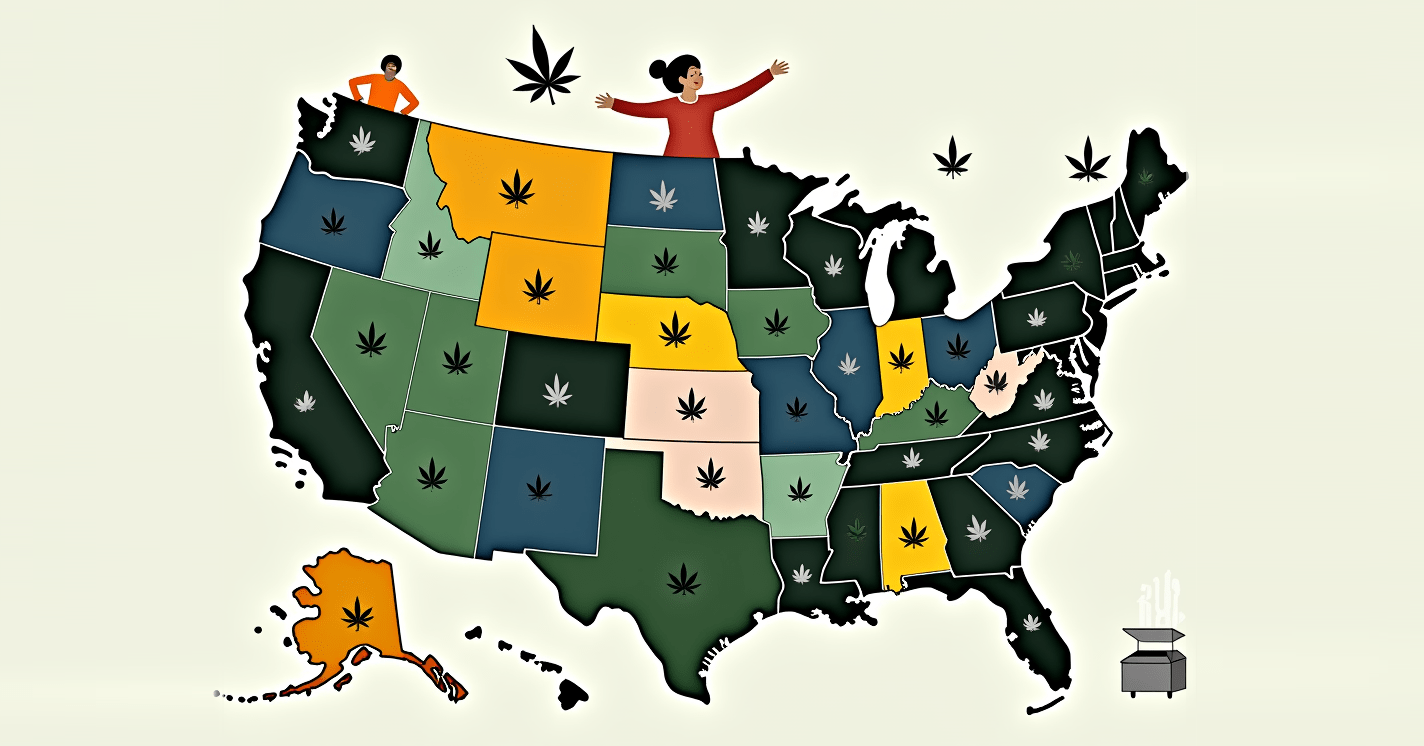As the 2024 election draws near, many states are gearing up to vote on cannabis laws. The push for marijuana reform continues to gain momentum across the United States.
If all proposed measures pass, marijuana could be legal in half of US states after the 2024 election. This marks a significant shift in public opinion and policy surrounding cannabis use.
Voters in several states, including North Dakota, South Dakota, Nebraska, and Florida, will see proposals to legalize recreational cannabis on their ballots. These initiatives have the potential to reshape the legal landscape for marijuana use and possession across the country. Each state’s measure differs slightly, reflecting local concerns and priorities.
Overview of Cannabis Laws in the United States
Cannabis laws in the U.S. are complex and rapidly changing. The legal landscape varies widely between federal and state levels, with significant economic impacts and shifting public opinions.
Federal vs. State Cannabis Regulations
The U.S. federal government still classifies cannabis as a Schedule I controlled substance. This means it’s illegal at the federal level. However, many states have passed their own laws legalizing cannabis for medical or recreational use.
This conflict creates challenges for businesses and consumers. Banks often hesitate to work with cannabis companies due to federal restrictions. Interstate commerce of cannabis products remains prohibited.
State laws vary widely. Some allow only medical use, while others permit both medical and recreational use. Each state sets its own rules for possession limits, sales, and cultivation.
Current Legal Status across States
As of October 2024, 24 states have legalized recreational marijuana. An additional 14 states allow medical use only. This leaves 12 states where cannabis remains fully illegal.
Recent changes include:
- Ohio legalized recreational use in November 2023
- Minnesota legalized recreational use in May 2023
Several states are considering legalization measures in upcoming elections. These include:
- Florida
- Nebraska
- South Dakota
Economic Impact of Legalization
Cannabis legalization has created new economic opportunities in many states. The industry generates:
- Tax revenue
- Job creation
- New business opportunities
Legal cannabis sales in the U.S. reached $33 billion in 2023. This number is expected to grow as more states legalize.
Tax revenue from cannabis sales helps fund:
- Education
- Infrastructure projects
- Substance abuse programs
The industry has also created thousands of jobs in cultivation, retail, and related sectors.
Public Opinion on Cannabis Legalization
Public support for cannabis legalization has grown steadily in recent years. A 2023 Gallup poll found that 68% of Americans favor legalization.
Support varies by age group and political affiliation:
- Younger adults tend to be more supportive
- Democrats show higher support than Republicans
Reasons for support include:
- Potential medical benefits
- Criminal justice reform
- Economic opportunities
Opposition often cites concerns about:
- Public health
- Impaired driving
- Youth access
As public opinion shifts, more states are likely to consider legalization measures in coming years.
Key States to Monitor in the 2024 Elections
Several states are poised to make significant changes to cannabis laws in the upcoming election cycle. Some swing states may shift their stance on cannabis policy. Other states have ballot measures or legislative initiatives in the works.
Potential Swing States on Cannabis Policy
Arizona’s cannabis market has grown quickly since legalization. The state generated over $1 billion in sales in 2022. This success could influence other swing states.
Michigan is another key state to watch. Recent polls show a tight race, with Harris holding a slim lead over Trump. Cannabis policy could be a deciding factor for some voters.
Nevada, which has a legal cannabis market, remains a battleground state. Its policies on cannabis could sway undecided voters in 2024.
States with Upcoming Ballot Measures
Florida may have a cannabis legalization measure on the 2024 ballot. If approved, it would be a major shift for this populous state.
Ohio voters will decide on adult-use cannabis in November 2023. The outcome could carry over into the 2024 election discussions.
Pennsylvania is considering a ballot initiative for 2024. As a key swing state, its cannabis policy could have national implications.
States with Legislative Initiatives
New York recently launched its adult-use market. The success or challenges of this rollout may influence other states’ legislative efforts.
Virginia’s new legal market is set to open in 2024. How smoothly this transition goes could impact other states’ decisions.
Minnesota passed adult-use legislation in 2023. Its implementation process will be closely watched by other states considering similar moves.
Election Dynamics Influencing Cannabis Policy
Political parties, voter demographics, and campaign strategies play key roles in shaping cannabis policy outcomes. These factors interact in complex ways, creating a dynamic landscape for cannabis legalization efforts across states.
The Role of Political Parties
Political party stances on cannabis vary widely. Democrats often support legalization, while Republicans tend to be more cautious. Some Republicans are shifting towards support, especially in states where cannabis legalization is on the ballot.
Party control of state legislatures impacts the likelihood of cannabis bills passing. In Democrat-controlled states, reform efforts move faster. Republican-led states may focus on medical use rather than full legalization.
Third parties like Libertarians can influence the debate by pushing for full legalization. This pressure sometimes leads major parties to adopt more progressive stances on cannabis.
Influence of Voter Demographics
Age is a major factor in cannabis policy views. Younger voters strongly favor legalization, while older voters are more skeptical. This gap affects turnout and voting patterns.
Urban voters tend to support legalization more than rural voters. This urban-rural divide shapes cannabis policy at the state level.
Education and income levels also play a role. College-educated and higher-income voters often show more support for legalization.
In swing states, voter demographics can be crucial. Close races may hinge on turnout among pro-cannabis voters.
Impact of Political Campaigns
Candidates’ stances on cannabis can sway voters, especially in tight races. Some politicians use cannabis reform as a key campaign issue to attract younger voters.
Pro-cannabis groups run targeted ad campaigns to raise awareness. These efforts aim to boost turnout among supporters of legalization.
Opponents of legalization also mount campaigns. They often focus on potential negative impacts on public health and safety.
Fundraising plays a big role. The cannabis industry increasingly donates to cannabis-friendly candidates and causes.
Debates and town halls give candidates platforms to clarify their cannabis positions. These events can shape public opinion and influence voting decisions.
Case Studies of States’ Shift in Cannabis Laws
Several states have made big changes to their cannabis laws in recent years. Some have successfully legalized marijuana, while others faced setbacks in their efforts.
Successful Legalization Efforts
Colorado and Washington led the way in 2012 by legalizing recreational marijuana. Their success sparked a wave of legalization across the country. By 2024, 24 states had legalized adult-use cannabis.
California, the most populous state, legalized recreational use in 2016. This move had a big impact on the national cannabis market. The state’s large economy and progressive policies influenced other states to follow suit.
Michigan became the first Midwestern state to legalize in 2018. This opened up a new region to the cannabis industry. Michigan’s success encouraged neighboring states to consider similar measures.
Challenges and Reversals
Not all legalization attempts have gone smoothly. South Dakota voters approved recreational use in 2020, but a judge later overturned the decision. The state’s residents may vote on the issue again in 2024.
Nebraska has struggled to get medical marijuana on the ballot. Despite strong public support, legal challenges have blocked several attempts. The state might vote on medical cannabis in 2024.
Florida faced obstacles in implementing its medical marijuana program. Delays and restrictions frustrated patients and businesses. The state is considering full legalization
Implications of the 2024 State Elections
The upcoming state elections will likely shape cannabis policies across the country. Key votes may lead to significant changes in state laws and potentially influence federal legislation.
Forecasting Changes in Cannabis Policies
Several states are set to vote on cannabis-related measures in 2024. These votes could expand legal access in some areas while potentially restricting it in others.
States considering legalization may see new tax revenue and job creation. However, implementation challenges could arise.
Some ballot initiatives aim to allow medical use. This could help patients access cannabis treatments more easily.
A few states may vote to decriminalize possession. This could reduce arrests and court cases for minor offenses.
Long-term Predictions for National Legislation
The 2024 election results may impact federal cannabis policy. More states legalizing could increase pressure on Congress to act.
If pro-cannabis candidates win key races, national reform efforts may gain momentum. This could lead to changes in banking regulations or rescheduling of cannabis.
A shift in Senate control could affect the chances of federal legalization bills passing. However, bipartisan support for some measures exists.
State-level successes may serve as models for potential federal policies. Lessons learned could shape future national legislation.
Strategies for Advocacy and Voter Engagement
Effective advocacy and voter engagement are key to influencing cannabis law reforms in state elections. These strategies focus on educating the public and building support for policy changes.
Educational Campaigns and Public Outreach
Educational campaigns play a vital role in informing voters about cannabis laws. These efforts aim to clear up misconceptions and provide accurate information.
Key elements of successful campaigns include:
- Social media outreach
- Community forums
- Informational websites
- Fact sheets and brochures
Advocates can partner with local organizations to reach wider audiences. They may also use targeted ads to reach specific voter groups.
Public events like town halls allow for direct engagement with voters. These settings provide opportunities for Q&A sessions and discussions on cannabis policies.
Mobilizing Support for Reform
Mobilizing support involves turning awareness into action. This process focuses on getting voters to the polls and encouraging them to support cannabis reform.
Effective mobilization tactics include:
- Voter registration drives
- Get-out-the-vote campaigns
- Phone banking and text messaging
- Door-to-door canvassing
Youth engagement is crucial. Advocates can work with schools and colleges to register new voters.
Creating volunteer networks helps spread the message. These groups can organize events and rallies to build momentum.
Digital tools like email campaigns and online petitions can also boost support. They allow supporters to take quick, easy actions to show their stance on cannabis laws.
Analysis of Pre-Election Polling Data
Recent polls show shifting attitudes on cannabis legalization. Voter opinions vary by state and demographic group. Cannabis policy links to other key election issues.
Voter Sentiments on Cannabis Issues
Early voting data suggests high interest in cannabis reform. In states with ballot measures, support ranges from 55% to 68%. Young voters aged 18-34 show the strongest backing at 72%.
Rural areas express more concern, with 45% opposed. Medical use garners wider approval than recreational.
Key voter priorities:
- Tax revenue allocation
- Criminal justice reform
- Industry regulations
A notable 62% of likely voters favor federal legalization. This marks a 5% increase from 2020 polls.
Correlation with Other Election Issues
Cannabis policy ties into broader election themes. Economic concerns top voter lists, with 47% citing job creation potential.
Criminal justice reform ranks second. 38% of voters link cannabis laws to racial equity issues.
Healthcare debates often reference medical marijuana. 41% of voters in key states want expanded access.
Environmental policies connect to cultivation practices. Sustainable growing methods matter to 29% of environmentally-focused voters.
State budget discussions frequently mention potential tax windfalls. 53% of fiscal conservatives support legalization for its revenue potential.
Post-Election Review
The 2024 state elections brought significant changes to cannabis laws across the country. Voters made their voices heard on ballot measures and elected officials who shaped new policies.
Election Outcomes and Their Effects
Several states passed new cannabis laws through ballot initiatives. Ohio legalized adult-use cannabis, joining the growing list of states with legal recreational markets.
These election results will lead to policy shifts in the coming months. New regulatory frameworks will be developed in states that legalized cannabis.
Existing medical programs may see updates based on voter-approved changes. Law enforcement practices will adapt in areas that passed decriminalization measures.
Emerging Trends in Cannabis Legislation
The 2024 elections revealed some clear trends in cannabis policy. More conservative states showed openness to medical cannabis programs.
Voter turnout increased in areas with cannabis measures on the ballot, especially among younger demographics. This signals growing public interest in cannabis reform.
Social equity provisions were included in many successful ballot measures. These aim to address past harms from cannabis prohibition.
Interstate commerce agreements gained traction in some regions. This could pave the way for a more connected cannabis industry in the future.
Public health and safety remained key focuses. New laws often included funding for education and addiction treatment programs.
Join the CalmEffect Insider Club
Get exclusive access to insider-only deals, groundbreaking news, and expert guides right in your inbox.







